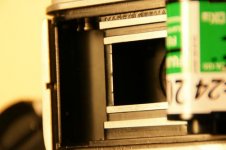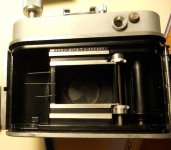D437
Member
I have an old Dejur D1 which scratches the emulsion in several places on rewind (not on forward). You can see why on the attached photos--one has arrows pointing to the three locations. Not sure how this happened originally but as you see with the film moving to the left on rewind it would come in contact with those three rough/raised areas. I'm wondering about solutions or recommended grades of emery paper to use on it --probably while someone else holds a vacuum right there to keep the filings out of the camera. then I'd have to paint smoothly. Perhaps it could be unbent if hit very precisely...??



